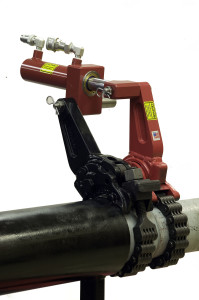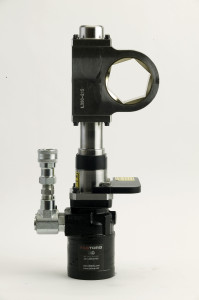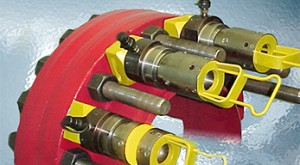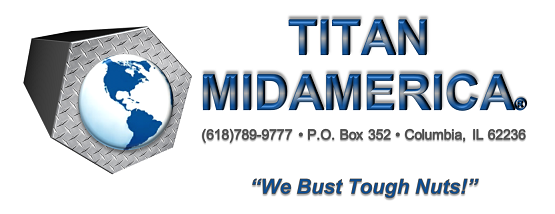10 Design Traits to Look For in Your Tool Purchases
Seat belts, air bags, flame resistant clothing and many other safety improvements are a benefit of modern living. Thankfully, tool safety features are no stranger to the same safety evolution.
Tool operators no longer have to live with archaic practices and behind-the-times tool design. Nut splitters now replace the unsafe practices of blowtorches and slugging wrenches. Safe tools are available, but you just need to know what to look for and where to find them.
By understanding the following 10 safe tool design traits, you will have a clearer picture of what to expect from your tools.
1. Reduced tool operation time = Less opportunity for accidents.
It is not hard to understand that the less time an operation takes for completion, the less the likely something could go wrong. By finding tools that can reduce the time it takes to get the job done correctly, you are reducing the chances you will have an accident.
2. Complex tools can increase the odds of injury.
Complex tools have a lot of parts that need increased skill and sometimes additional operators. The harder the tools make operation, the increased odds an injury can occur. By following the premise of less is more, a tool that performs the same task as well as another comparable tool, but does it with fewer parts, is inherently safer.
 3. Removing direct tool operation significantly reduces operator hazards
3. Removing direct tool operation significantly reduces operator hazards
If a person doesn’t need to put him or herself in harms way to operate a tool directly, the increased safety benefits are tremendous. Most opportunities for injury are eliminated. Remote operable tools are a dream for safety and risk management professionals.
A perfect example of a tool that is designed to operate efficiently and remove the operator from a dangerous operating environment is the AutoTORQ Hydraulic Chain Pipe Wrench. This tool provides a drastically safer and faster alternative to the hands-on set up of tongs and come-a-longs to make-up and break-out pipe on drill decks and in pipe yards and shops.
Just by latching the chain of the AutoTORQ Hydraulic Chain Pipe Wrench around the pipe, adjusting the slack with the tensioning nut and pressing a button, direct user operation is eliminated in the dangerous and even deadly- 4-foot area around the pipe.
 4. The more operational steps a tool needs to work, the increased odds problems can occur.
4. The more operational steps a tool needs to work, the increased odds problems can occur.
When a tool needs to go through several steps to operate, the increased likelihood it will encounter a problem also increases, along with an increased opportunity to cause injury.
Since a ratcheting torque wrench must energize multiple times to torque a nut, it must re-establish a reaction point every time it re-energizes. Simply finding a torque wrench that doesn’t need to re-energize more than once for the torqueing process, like the SpinTORQ 360-Degree Continuously Rotating Torque Wrench, you reduce the multiple opportunities for tool failure and potential injury.
5. Fewer pinchpoints means less chance of injury.
This one is pretty simple. The less pinchpoints a tool has, the lower the chance someone will get a finger or body part damaged in them.
6. Appropriate tool construction and better materials lowers the risk of tool damage and associated injury.
Like most things in life, the better a tool is built the better chance it has of not breaking down. Sometimes, when tools break due to poor construction or inappropriate materials, they become safety hazards. Parts and pieces become projectiles that cause injury and even death. By ensuring you buy tools that have the best construction and materials for their intended operation, you are reducing the potential for harm.
7. Lower operation requirements reduce risk.
Tools that lower the requirements on hydraulic pressure and other operational ranges immediately reduce the tool’s safety risk. Lower hydraulic pressure reduces the likelihood of serious harm if a pinhole in the pressurized hose or other failure occurs.
By finding innovative tools, like the ones manufactured at FASTORQ, that work to reduce operational requirements while striving to be faster and tougher than industry standards, you not only get a safer operation range but the best tool for the job. You cannot beat that combination of features for improving both safety and performance.
 8. Repetitive motion causes long-term injury to operators.
8. Repetitive motion causes long-term injury to operators.
Think about how much turning is required when installing or removing a standard stud tensioner. Now repeat this turning motion thousands of times throughout the course of a worker’s career. Not only is this job extremely time consuming but it is just asking for work-related injuries at some point, such as carpal tunnel syndrome.
Tools that make operation faster reduce the time in which an injury can occur, but they also reduce repetitive motion injury. Replacing a standard stud tensioner with a ZipTENSIONER, which is a tensioner that simply slides on and off a stud in seconds, eliminates the repetitive motion of standard tensioners along with a significantly improving the amount of time required to get the job done.
Like the ZipTENSIONER, FASTORQ brings many innovative tools based on the patented ZipNut technology to the table which offer both increased performance as well as safety.
9. Reducing operator fatigue reduces the number of related accidents.
Let’s use the standard stud tensioner example again. Imagine how exhausting screwing multiple stud tensioners on and off a flange can be. Now, multiply this by the multiple times they need to go on and off the flange in order to properly tension that flange. It’s exhausting even thinking about it. No wonder accidents happen when people are this tired.
By using a tool like the ZipTENSIONER (mentioned in #9), you can significantly reduce tensioning time by up to 90 percent and radically reduce operator fatigue just by choosing a tool that requires a lot less physical effort and time. Accidents from exhaustion are less likely to occur when the right fatigue-reducing tool is implemented.
![FastBAK-on-flange[1] copy](/wp-content/uploads/FastBAK-on-flange1-copy-275x300.jpg) 10. Eliminating inherently unsafe practice through tool design increases safety.
10. Eliminating inherently unsafe practice through tool design increases safety.
We’ve all seen that guy beating on a back up wrench to get it loose. We even know that it is not safe.
So, instead of just falling into the routine of “this is what we’ve always done,” it’s time to find a tool that doesn’t force you into an unsafe practice. An example of a safe back-up wrench is FASTORQ’s FastBAK. It has a quick release action arm that eliminates the need to beat on it to get it loose. This eliminates the safety hazards associated with accepting the old unsafe standard.
Thanks to research and improvements in technology, we have safety features today we’ve never had before. Industrial tools are also part of this safety evolution. Understanding the 10 traits to look for in safe tool design is an important part of keeping you and your workers stay safe in the workplace.
Share
OCT
2013
